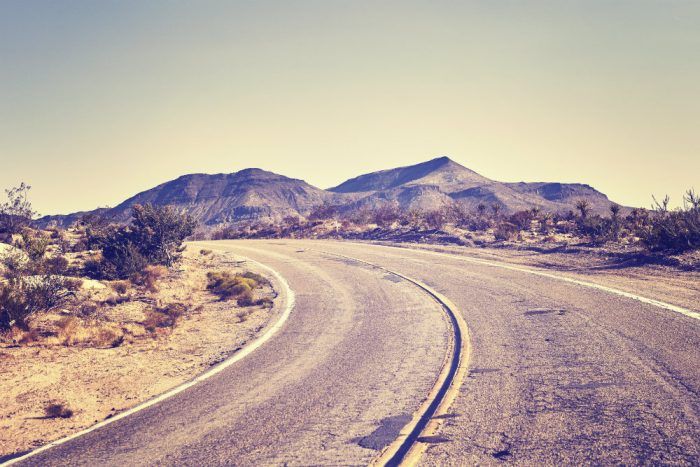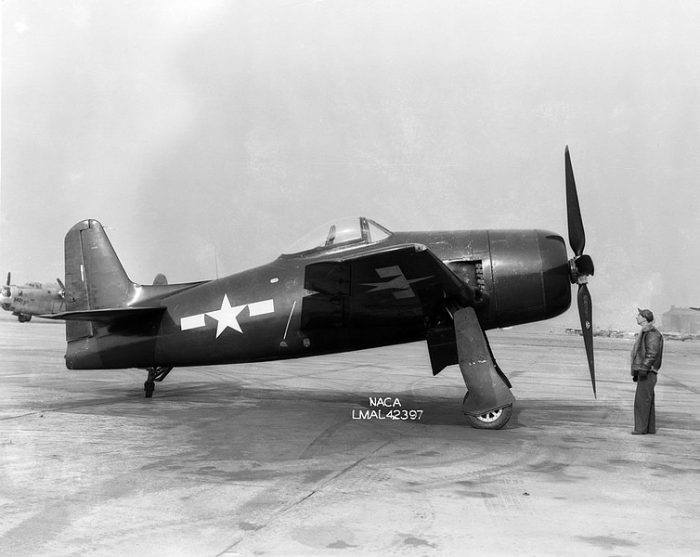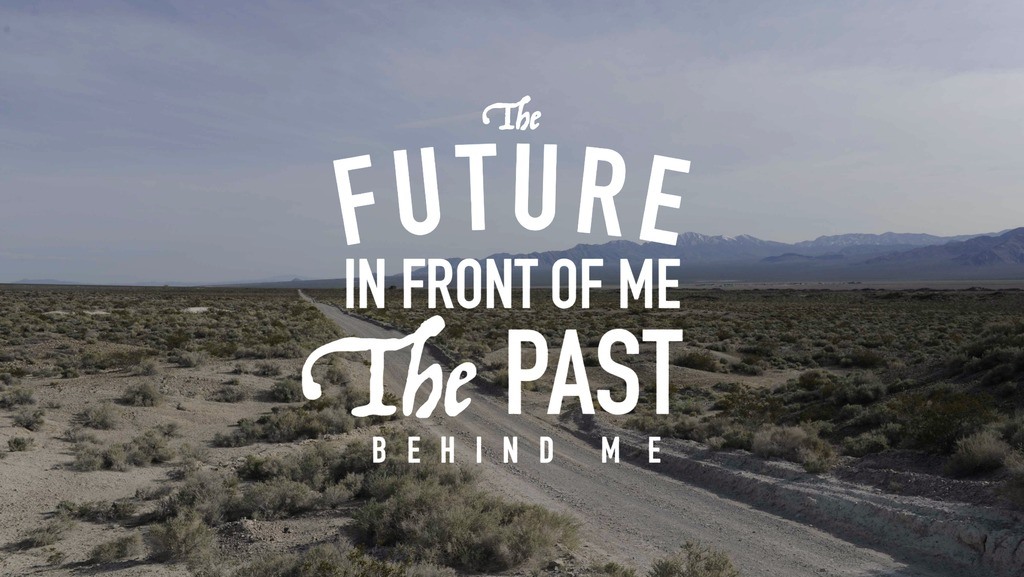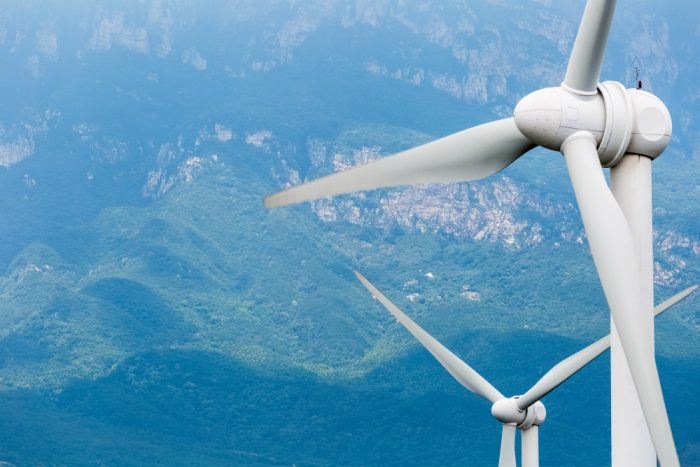The Future In Front of Me, The Past Behind Me is a gasoline-fueled narrative by automotive journalist Tony Borroz. It details the joys, thrills, and even the uncertainties of the car-obsessed lifestyle. In advance of the book’s release, we are previewing the first few chapters.
Below is the first half of chapter 4, Leaving Palm Springs. We will announce the book’s release later this year on our Twitter page.
I fill my tank with gas at the unattended station. The cool morning desert air is still and the sun is somewhere over there, on the other side of a ridge of rocks that could be from a movie set. Late January in the desert southwest is pleasant in the extreme. It’s cold now, of course. Sand and dirt and what passes for plants out here hold as much heat as a sieve, but by midday, it’ll be warmer than 90 percent of the country.
Driving here, now, at this time of day gives the whole place an odd ghost town feeling. By the time I am out of Palm Springs, I have seen less than a dozen other humans. It’s not that early, but no one seems to be getting to their jobs, what people there are around here that actually work. Also missing are those crack-of-dawn-retiree walkers that I’ve seen in other places. Honestly, morning people worry me. My dad was a morning guy. He could wake up at 4:00 o’clock fresh as a daisy, ready and raring to go. And most of the time he’d drag us with him. I am not a morning person. Most writers are not. My tendency is to stay up late, sleep late, get up late.
Quiet & Empty
There are, however, those times when getting up early is Necessary and Required. Watching Grand Prix races on TV is one of them. Another one is getting on the road. No, this isn’t 4:00 friggin’ o’clock in the morning, but it’s early enough for me. By the time this day is over I am going to be in a completely different world, climatologically speaking. On top of that, I am going to have to skirt around the “greater L.A. area.”
Sure, sure, the navigation lady in my phone is urging me to take the direct route, right to the 5, then north. She pleads with me not to head out through Lancaster and such, saying it will add to my travel time. But I know she’s lying to me. Like I am going to drive through the very definition of “bad traffic” because she thinks it’s a good idea.
So I more or less know my route, but for the moment I am driving through the broad, overly manicured, lovingly cleaned and swept streets of Palm Springs, deserted to a level befitting a biological plague, heading past the airport.

Plane Site
The airport is a place of consternation for the well-healed residents of Palm Springs. Some airline or another has been granted the right to fly in something larger than a Piper Cub, and the residents are anxious about the noise. As I drive by the airstrip, I see two Boeing BBJs – Boeing Business Jets, the personal plane version of the 737 airliner (and coincidentally a project my host in Palm Springs, Bob, worked on at The Lazy B) – a literal handful of Gulfstreams, a bunch of Lears, Embraers and other such Maybachs of the skies and, somewhat incongruously, a line of older prop planes. There’s a T-6 Texan WWII-era trainer, and there’s another Texan and that’s a . . . “Holy shit! That’s a Bearcat!” I say out loud to myself.
The Grumman F8F Bearcat was a piston-engine, single seat naval fighter from the Second World War. It entered service very late and saw very little action. Which is a pity, cause Bearcats were pipe-hitting SOBs of an airplane. Distressingly small and deliciously over-engined, Bearcats could and would tear to you pieces. The pilots that flew them unequivocally say they were the best prop-driven plane in the Pacific. Corsairs? Bearcats could out turn them, and with their four 20 mm canons, out gun them. Nakajima Ki-84 Franks (as in the “Forget it, it’s a Frank” warning to U.S. pilots) and Raidens and literally anything else the Imperial Army or Navy of Japan could put up against it were little more than targets.
If you were piloting a Grumman F8F Bearcat, your power and capabilities gave you a god-like invulnerability. You had the firepower and the maneuverability to beat anyone in the skies, and if you messed up, that Pratt & Whitney Double Wasp had enough power and speed to get your butt out town and away before the enemy knew you’d ducked out.
Of course, all of the power and capability of the Bearcat was rendered irrelevant by the jet engine. Even the early jet fighters that were introduced about the same time as the Grumman F8F were a literal revolution in the air. Speeds were up by 50 percent at a stroke; turning loads were instantly flirting with blackout levels of g-force. Those once “what if” talking points at the local pilot watering hole were now possible because of the Grumman F8F Bearcat and its late-war ilk.

Out With The Old
New technology can render older calculations meaningless by the end of the first day of its life. This applies to cars just as well as airplanes (or computers or home heating or medical knowledge, literally everything). In 1959 the world of high speed oval racing was a known technical quantity at places like Indianapolis Motor Speedway. If you wanted to go fast, you built up a big, front-engined roadster made by the likes of A.J. Watson or Quinn Epperly, kicked butt, drank the milk, and took home the Borg-Warner Trophy. Until this half-nuts Australian named Jack Brabham showed up in a British made Cooper with an engine half the size of an Offenhauser in 1959.
And that wasn’t the half of it.
To make matters even stranger, the engine was in the back of the car! Who did that? Would that even work? Was that even legal? To answer that, answer this: When was the last time you saw a front-engined formula car? Exactly. Technology, at the stroke of a pen on a drawing board, redrew what this New World of vehicular transportation would look like.
I was thinking of that – the technological progress that moves inexorably over our automotive world – as I got to the other side of Palm Springs; the cloverleaf swoop onto the 10 to head west by north to full north when I saw them: scores and scores of giant wind turbines. It would seem that Palm Springs or the county or whoever is in charge of the local community, decided to get into wind power in a sizeable way. All but just a few were casually turning away, literally making electrical power out of thin air.
In With The New
And why not? Palm Springs is in a fairly windy place, so why not grab some of that kinetic energy rather than letting it go by? The same goes for solar power, especially down here. During my time in Arizona it was mystifying to me there weren’t solar panels and solar water heaters on every roof of every building in the state. It’s sunny 284 days of the year. That’s nearly 78 percent of the time. How can you not take advantage of all that free thermal energy otherwise going to waste?
When I lived on Oahu, one of the houses I lived in had solar water heater panels. These were bone-simple affairs: a shallow box painted flat black and covered with Plexiglas. Inside was a serpentine of black, four-inch PVC pipes running back and forth, pumped full of circulating water. That was it. That’s where 100 percent of my hot water came from. Curious, I held a meat thermometer under the hot water when I first moved in. 148 degrees. That was the water temp coming out of the tap. Heated only by the sun. Impressive, to say the least. I noticed that all the government buildings (including military and low income housing) all had solar water heaters. Why not? Not using solar power, both for heating and for electrical power generation, is like walking by a pile of money and saying, “Oh no, I don’t need any more money.”
It was easy to see our future in a town as fortunately located as Palm Springs. With the killer confluence of lots of wind, lots of sun, and lots of eco-conscious rich white people from Hollywood, you don’t have to be a wizard to see the path forward. From all those (eventual) solar panels and current wind turbines, direct to your home, and from there, direct to your Tesla. Eventually, when it’s not for your $100,000 Tesla, but when it’s for your $22,000 Chevy EV and electric buses and such, it will be for all of us.
Still, the Grumman F8F Bearcat was a helluva plane, no two ways about it. But if I’m flying a North American F 86 Sabre, it’s a target.
Tony Borroz has spent his entire life racing antique and sports cars. He is the author of Bricks & Bones: The Endearing Legacy and Nitty-Gritty Phenomenon of The Indy 500, available in paperback or Kindle format. His forthcoming new book The Future In Front of Me, The Past Behind Me will be available soon. Follow his work on Twitter: @TonyBorroz.



